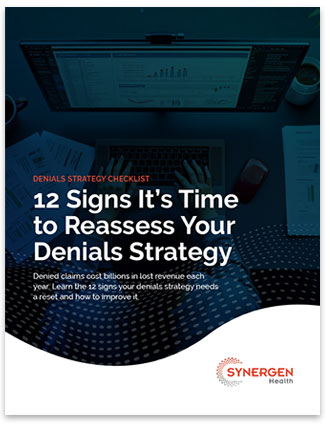 Claim denials have long been considered a backend nuisance—something to clean up quietly while keeping the rest of the revenue cycle moving. But today, denial management has become a defining challenge for healthcare organizations. It’s no longer just a reimbursement issue; it’s a financial, operational, and even reputational threat.
Claim denials have long been considered a backend nuisance—something to clean up quietly while keeping the rest of the revenue cycle moving. But today, denial management has become a defining challenge for healthcare organizations. It’s no longer just a reimbursement issue; it’s a financial, operational, and even reputational threat.
In 2023, nearly 1 in 5 in-network claims were denied. That’s nearly 20% of legitimate services that healthcare providers expected and needed to be reimbursed for. At the same time, denial resolution is becoming increasingly complex, with mounting documentation requirements, narrower appeal windows, and payers doubling down on automation.
The result: teams overwhelmed by volume, buried in manual work, and often collecting less than half of what they’re owed.
Denied Claims Are a Systemic Problem, But Most Strategies Haven’t Evolved
The real problem isn’t just the number of denials—it’s how unprepared most systems are to manage them.
Today, nearly half of healthcare providers still review denials manually, using a patchwork of spreadsheets, emails, and outdated workflows. These reactive approaches create inefficiencies, extend days in A/R, and fail to prevent the same errors from happening again.
Many health systems lack the visibility to track denial patterns across service lines or payers. Others aren’t sure which denials are worth appealing—or how to prioritize limited resources to recover the revenue that matters most. And all too often, front-end teams and RCM teams operate in silos, making it harder to catch issues upstream before they affect reimbursement.
Meanwhile, the cost of denial recovery is ballooning. U.S. hospitals now spend an estimated $19.7 billion annually trying to overturn denied claims. And even then, the return is diminishing.
If any of the following challenges sound familiar, it may be time to take a closer look at your systems and workflows:
- You’re seeing repeat denial trends that point to preventable issues.
- You don’t know your current denial rate, or it’s consistently above 15%.
- Your appeals are inconsistent, delayed, or based on guesswork.
- Denials are directly affecting your cash flow and patient experience.
- Your teams are working in silos without shared ownership or visibility.
These aren’t just operational hiccups—they’re red flags that can have lasting financial consequences.
Is Your Denied Claims Strategy Working for You? These 12 Indicators Can Help You Find Out
To help healthcare leaders identify whether their current denial strategy is truly working (or just treading water), we’ve compiled a guide that outlines 12 signs it’s time to rethink your approach.
This downloadable guide includes:
- Common denial trends and what they signal
- Benchmarks to assess your current performance
- Steps to shift from reactive to proactive denial management
- Strategic use cases for automation and AI in resolving and preventing denials
If your organization is facing growing denial volumes, expanding service lines, or increased financial pressure, this guide can help you pinpoint what’s holding your revenue cycle back and where to start fixing it.
Ready to take a closer look at your denials strategy?
Download the full guide here and see how your approach stacks up.


